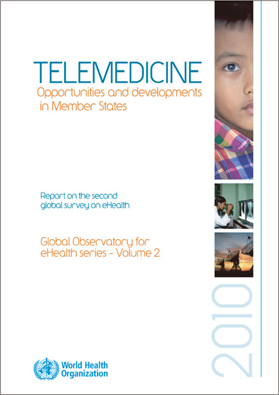Information systems and communication technologies (ICTs) gave us new and innovative wave of communication life such as living in cyber space, instant messaging, and communications with whom anyone in anywhere. These are changing not only life-style, but also mode of business in every industry.
Health care service industry is resource-intensive, process-oriented, and doing business traditionally by method of confrontation between medical professionals and patients. ICTs have great potential to address some of the challenges faced by both developed and developing countries in providing accessible, cost-effective, high-quality health care services. Telemedicine uses ICTs to overcome geographical barriers, and increase access to health care services. These are particularly beneficial for rural and underserved communities in developing countries - groups that traditionally suffered from lack of access to health care.
In light of this potential, the World Health Organization (WHO) established the Global Observatory for eHealth (GOe) to review the benefits that ICTs can bring to health care and patients' wellbeing.
The Observatory is charged with determining the status of eHealth solutions, including telemedicine, at the national, regional, and global levels, and providing WHO's Member States with reliable information and guidance on best practices, policies, and standards in eHealth.
In 2005, following the formation of WHO's eHealth strategy, the Observatory conducted a global eHealth survey to obtain general information about the state of eHealth among Member States. Based on the data from that survey, the GOe carried out a second global survey in 2009; it was designed to explore eight thematic areas in detail, the results of each being reported and analysed in individual publications - the Global Observatory for eHealth series.
The telemedicine module of the 2009 survey examined the current level of development of four fields of telemedicine: teleradiology, teledermatogy, telepathology, and telepsychology, as well as four mechanisms that facilitate the promotion and development of telemedicine solutions in the short- and long-term: the use of a national agency, national policy or strategy, scientific development, and evaluation. Telemedicine - opportunities and developments in Member States discusses the results of the telemedicine module, which was completed by 114 countries (59% of Member States).
There are comprehensive reviews about telemedicine in the world;
Overview of telemedicine: definition, history, applications, and potential barriers to telemedicine diffusion
Telemedicine in developing countries such as Mongolia, Mexico
Barriers, Legal and ethical considerations, to realizing the promise of telemedicine in developing
Implications for telemedicine development, implementation, evaluation, and sustainability
GOe Second Global Survey on eHealth: Methods and process
Telemedicine services in the world by groups
Telemedicine initiatives occurring around the world Norway's teleECG initiative
Factors facilitating telemedicine development: Governance, policy and strategy, scientific development, evaluation processes
The Swinfen Charitable Trust Telemedicine Network
Discussions and recommendations about factors facilitating and barriers to telemedicine development
Following the analysis of the survey results, WHO recommends steps Member States can take to capitalize on the potential of ICTs. One such step is creation of national agencies to coordinate telemedicine and eHealth initiatives, ensuring they are appropriate to local contexts, cost-effective, consistently evaluated, and adequately funded as part of integrated health service delivery. Ultimately telemedicine initiatives should strengthen - rather than compete with - other health services.
Korea has been implementing trial projects of telemedicine in limited service area and populations for more than twenty years from the late 1980s. The Korean Government continued trial projects to develop safe and efficient telemedicine model, and intended to economic buildup. However, medical professional groups think that telemedicine would not be safe, and they are worried about whether it would be beneficial to themselves and patients.
Scientists and medical doctors in cooperation with ICTs companies and local governments have been tried various models of telemedicine for more than 20 years in Korea. Recently, effectiveness of telemedicine in public health care has been revealed: compliance and effectiveness of telemedicine of hypertensive patients in the underserved communities [
1,
2], and effectiveness of eHealth services of public area [
3], factors to adoption of telehealth services [
4], and the effect of eHealth services of managing metabolic syndrome in rural area [
5]. There are also accumulated and structured experiences and technological and managerial systems in participants of telemedicine projects.
In Korea, a bill about telemedicine to the limited underserved populations and communities was made and submitted to the national assembly in May, 2010. The Ministry of Health and Welfare should have more interest and be active to realize the needed and safe telemedicine services.
We recommend this report to those persons or groups interested about telemedicine in Korea and other countries that do not think about telemedicine, and are hesitating to adopt actively. Especially, we should understand what were successful service models and technological systems of eHealth in view of their culture and healthcare policy, and consider those factors facilitating and barriers of telemedicine recommended in the last of report. We expect that the report would be contributed that telemedicine be an alternative and useful solution to the communities underserved, and the general public, in case of limited and indispensible case.





 PDF
PDF ePub
ePub Citation
Citation Print
Print


 XML Download
XML Download